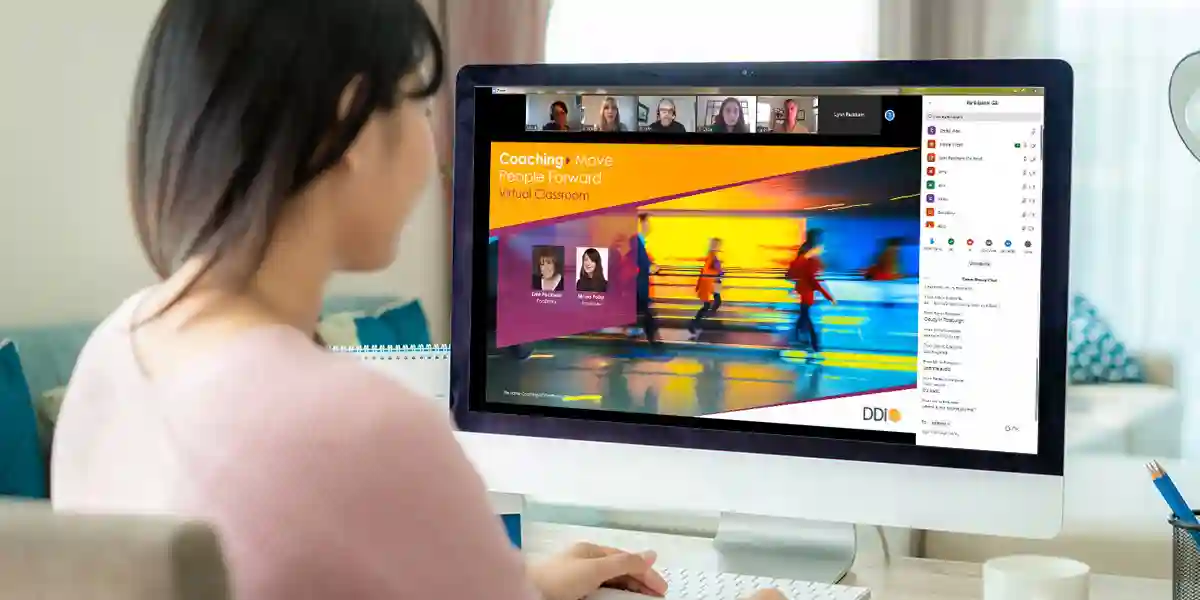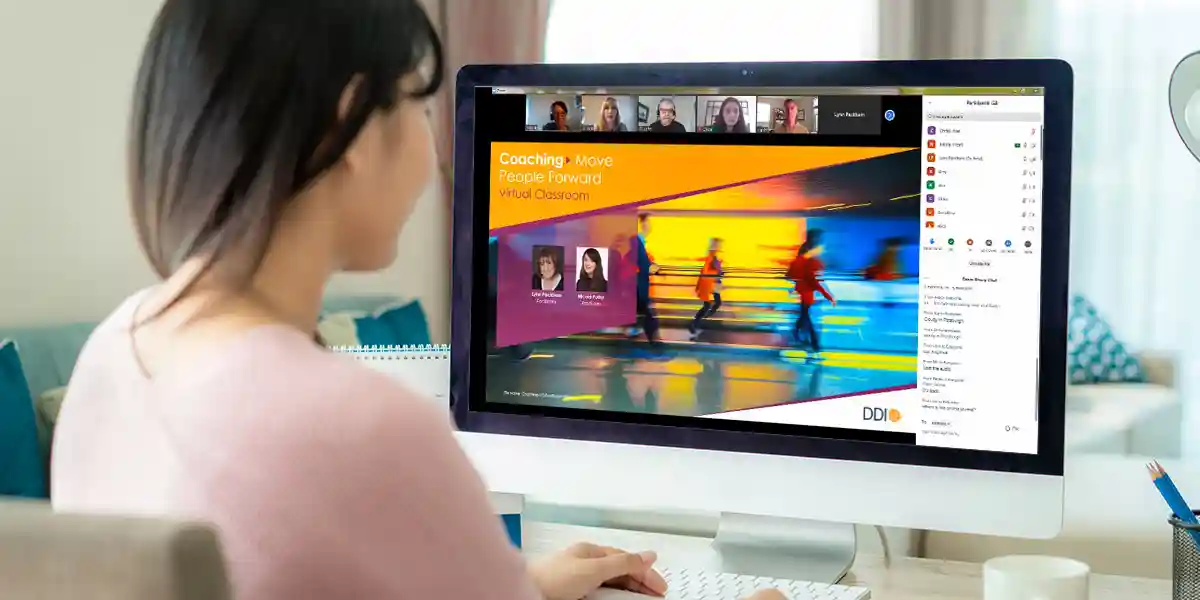In the leadership development realm, virtual classroom is a hot topic. This shouldn’t be a surprise. After all, everyone’s pivoting to digital. And they’re doing so for a great reason. They’re trying to figure out how to continue developing the critical skills leaders need now more than ever—and at this time, the development must be done virtually. So, they’re also trying to get their virtual classroom questions answered.
To help with clarity and direction, for the last several weeks we have ramped up our efforts to provide education about DDI’s virtual classroom delivery option. Based on our experience delivering virtual classroom training in the last decade, we’ve sought to give actionable advice to address many virtual classroom questions. And we’ve also shared overviews of our virtual classroom solution and our approach to creating virtual learning journeys.
Recently, we delivered a hugely popular webinar, “Virtual Classroom, Real Results: How to Get Started.” Nearly 1,500 people attended the live presentation and have viewed the webinar on-demand. You can check it out here.
This webinar also generated dozens of virtual classroom questions. These included questions about moving from traditional to virtual training. About best practices. About how to make virtual training stick. And even about what virtual classroom is, anyway.
Here are answers to some of the most-popular virtual classroom questions we received.
What is virtual classroom?
Training in a virtual classroom provides a synchronous learning environment allowing a group of learners to engage in learning at the same time. This facilitates a high level of interaction and engagement for sharing and to promote learning. In fact, at its best, virtual classroom has at minimum the same, or even greater amounts, of interaction than in-person training.
It’s also worth pointing out what virtual classroom is not. It isn't a catch-all term for all digital learning, including webinars and self-directed learning. Virtual classroom is a distinct modality that takes the classroom learning experience and moves it online.
What’s the difference between virtual classroom and a webinar in which the facilitator uses multimedia?
Typically, in a webinar the goal is to give information with limited interactivity. A course or workshop delivered in a virtual classroom, meanwhile, is designed to facilitate core learning objectives. These objectives can include improving awareness to building and transferring skills. And unlike a webinar, a virtual classroom course is designed to be highly interactive.
Is virtual classroom really a good substitute for classroom training?
Virtual classroom, when done right, is a very good alternative to in-person training. And with remote or globally dispersed teams, it may be your only option. When organizations follow the right best practices, the virtual classroom modality can be effective and result in behavior change. Best practices include the following:
- selecting and training the right facilitators
- always having a producer to manage the technology and user experience
- using a platform with a wide range of functionality (including breakout rooms)
- designing for interactivity
Delivering courses virtually also allows trainers to enhance their skill sets and their value as facilitators.
What’s a breakout room?
Like breakout groups or table teams in a classroom training environment, breakout rooms—a common feature of the virtual classroom modality—are used for a variety of activities. These include skill practices, small group activities using a whiteboard, and peer coaching. All these activities involve participants interacting with each other when placed in the virtual breakout rooms.
Keep in mind, when using breakout rooms, it’s best to account for a little more time in the class schedule to allow learners to navigate both the instructions they are given and the technology. Also, when you have a class size of 20 (the largest recommended size for a virtual classroom delivery), it’s best to keep the number of breakout room participants small. We recommend keeping the number to five or fewer, per room.
How important is a producer?
At DDI we have always used producers and see their role as very important to the success of a virtual classroom session. Prior to the session, the producer ensures the platform works properly and sends out links and any required materials. During the session, the producer handles any technology issues that arise. This allows the facilitator to focus on facilitating the session without distractions. You can develop producers with DDI's on-demand training.
How do you encourage participation, especially in the early stages of the session when the line may be quiet?
Set expectations ahead of time to create learning tension to encourage involvement. Let your learners know they’re not attending a listen-only webinar. Learners often can benefit from a little extra time to respond as they are learning to navigate the tools, so be comfortable with silence. Mix up the tools, use chat, and call on table teams to answer questions.
What’s the best way to keeping people focused and engaged in the learning?
Just as with a traditional classroom, engagement is created when learners are highly involved. Blending the course design, use of the tools, the interactive activities, and the requirements to participate in a variety of activities can keep learners fully engaged throughout the session.
Are webcams a necessity?
While ideal, it’s not necessary to have all participants on video. At DDI, we used a platform with great success for more than 10 years and we did not use webcams.
Given the current situation, however, in which so many of us are working from home and in-person interactions with peers are not possible, more individuals and organizations are using webcams to create a feeling of connectedness. At the same time, there is a lot of pressure on corporate and home Wi-Fi networks with so many people (including students) online at the same time. For that reason, some companies have told employees not to use webcams or videos right now. Our experience has shown that the absence of webcams does not have a negative impact on the learning experience.
Do DDI-certified facilitators need an additional certification to facilitate virtual classroom courses?
You do not need an additional certification to deliver DDI's virtual classroom courses. If you are not experienced in delivering training virtually, we encourage you to attend one of DDI's Facilitator Booster: Virtual Classroom sessions. You can register for one of these sessions from the Certifications and Workshops page on our website.
Can we adapt DDI’s virtual classroom solution to different video conference platforms?
Yes. While we have a standard platform we typically use, we can work with you to deliver a virtual classroom course on whichever platform you choose.
Compared to traditional classroom, is it harder to make virtual training “stick?”
The same implementation best practices required to make in-person training stick should be applied to virtual classroom programs. Also, it begins at the top—with senior leaders who are accountable for driving leadership development forward. What else is required? A solid implementation plan that links training solutions to business needs, and training curricula targeted to learners’ needs.
And, of course, learners need the proactive support of their own manager before, during, and after the training. Learners also need training programs, regardless of how they are delivered, that are engaging and relevant. Finally, they need training that provides tools and job aids they can and will use back on the job.
Check out our on-demand webinar, “The Shift to Virtual Classroom: How RealPage and Spectrum Found Success” to learn how two clients transitioned their in-person leadership training to live virtual experiences.
Alex Smith is a Managing Consultant within DDI’s U.S. Operations. He leads a team of consultants and is also the Engagement Manager for several large-scale client partnerships across the globe. Alex lives an hour outside of New York City with his wife, Lin, and their two young children.
Topics covered in this blog

